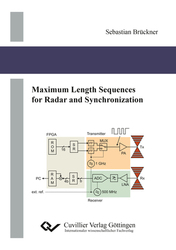| Fachbereiche | |
|---|---|
| Buchreihen (96) |
1378
|
| Nachhaltigkeit |
3
|
| Gesundheitswesen |
1
|
| Geisteswissenschaften |
2364
|
| Naturwissenschaften |
5406
|
| Ingenieurwissenschaften |
1793
|
| Allgemeine Ingenieurwissenschaften | 292 |
| Maschinenbau und Verfahrenstechnik | 862 |
| Elektrotechnik | 686 |
| Bergbau- und Hüttenwesen | 30 |
| Architektur und Bauwesen | 75 |
| Allgemein |
98
|
|
Leitlinien Unfallchirurgie
5. Auflage bestellen |
|
Erweiterte Suche
Maximum Length Sequences for Radar and Synchronization
Sebastian Brückner (Autor)Vorschau
Leseprobe, Datei (800 KB)
Inhaltsverzeichnis, Datei (570 KB)
This dissertation demonstrates the implementation of ultra-wideband (UWB) radar sensors using commercial off-the-shelf electronics. The sensors are based on the correlation of binary pseudo noise sequences (M-sequences), combining low transmit power requirements with excellent noise and interference suppression.
A ranging system is introduced that is able to track moving objects with a standard deviation of 1.73mm at 2m range. Subsequently, a system is developed which can synchronize itself to a reference sequence with 1.96ps RMS jitter. This synchronization system uses an analog correlating control loop (delay lock loop) to achieve tracking of the reference to 0.38% of one chip.
The final application shown is a ground penetrating radar (GPR). The system is comprised of three elements: an FPGA, an output driver for the transmitter and a commercial analog-to-digital converter. Comparative measurements on buried pipes and cables prove that this system has achieved detection capability comparable to commercially available pulsed GPRs.
| ISBN-13 (Printausgabe) | 9783736991927 |
| ISBN-13 (E-Book) | 9783736981928 |
| Buchendformat | A5 |
| Sprache | Englisch |
| Seitenanzahl | 158 |
| Umschlagkaschierung | matt |
| Auflage | 1. |
| Erscheinungsort | Göttingen |
| Promotionsort | Braunschweig |
| Erscheinungsdatum | 29.01.2016 |
| Allgemeine Einordnung | Dissertation |
| Fachbereiche |
Elektrotechnik
Nachrichten- und Kommunikationstechnik |
| Schlagwörter | ground penetrating radar, delay lock loop, synchronization, m-sequence, prbs |








